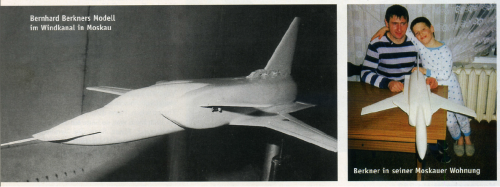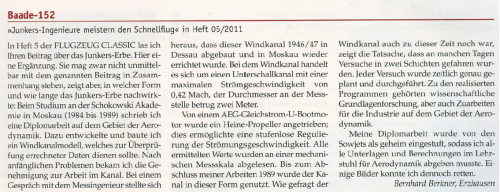You are using an out of date browser. It may not display this or other websites correctly.
You should upgrade or use an alternative browser.
You should upgrade or use an alternative browser.
Bernhard Berkner FSW Canard Fighter (looks like Grumman X-29)
- Thread starter hesham
- Start date
- Joined
- 11 March 2006
- Messages
- 8,608
- Reaction score
- 3,056
No information about this design in the text, which is mainly about the used wind tunnel,
which was dismantled 1946/47 at the Junkers plant in Dessau and rebuilt in Moscow.
It was a subsonic wind tunnel and was used at least until 1989, when the author finished
his work there.
Calculations and data about the design were classified by the Soviets, but Mr Berkner could
save some photos of it.
which was dismantled 1946/47 at the Junkers plant in Dessau and rebuilt in Moscow.
It was a subsonic wind tunnel and was used at least until 1989, when the author finished
his work there.
Calculations and data about the design were classified by the Soviets, but Mr Berkner could
save some photos of it.
- Joined
- 25 June 2009
- Messages
- 13,765
- Reaction score
- 3,009
Jemiba said:Calculations and data about the design were classified by the Soviets, but Mr Berkner could
save some photos of it.
Does this mean that Berkner himself had nothing to do with the design? In that case the topic's title is misleading.
- Joined
- 6 November 2010
- Messages
- 4,225
- Reaction score
- 3,151
The text says Berkner studied in Moscow, where he used the wind tunnel that was originally in Dessau. His work was classified as secret, but he managed to save a few pictures. I assume the images attached by Hasan are (some of) those pictures. The model shown would then be the result of Berkner's studies.
- Joined
- 1 April 2006
- Messages
- 10,725
- Reaction score
- 6,730
In Issue 5 of AIRPLANE CLASSIC I read your post about the Junkers heritage. Here a supplement. It may not be directly related to the above post, but shows , in what form and how long was still influencing the Junkers heritage: While studying at the Schokowski Academy (actually, Air Force Academy named after Zhukovsky) in Moscow (1984 to 1989) I wrote a thesis in the field of aerodynamics . To this end, I developed and built a wind tunnel model, which should be used to check calculated data. After initial problems, I got permission to work in the channel. In a conversation with the measurement engineer , it turned out that this wind tunnel was 1946/47, broken down in Dessau and rebuilt in Moscow. In the wind tunnel is a subsonic channel with a maximum Strömgcschwindigkeit of 0.42 Mach, the diameter at the measuring point was two meters .
From an AEG-Gleichström submarine engine a Heine propeller was driven; this allowed a stepless regulation of the flow velocity. All values were determined by a mechanical measurement scale . By the conclusion of my work in 1989 , the canal was used in this form. As asked , the wind tunnel was also at this time still shown by the fact that experiments were run in two shifts on some days . Each experiment was scheduled and performed exactly . Their completed programs were basic scientific research , but also preliminary work for the industry in the field of aerodynamics.
My thesis was classified as secret by the Soviets, so I had to give all documents and calculations in the Institute of Aerodynamics. Some still images I was able to save.
Bernhard Berkner, Erzhausen
Similar threads
-
Grumman Rakecat FSW fighter
- Started by martinbayer
- Replies: 2
-
Notional canard fighters by Rudolf and Robbert Das
- Started by hesham
- Replies: 3
-
German aircraft designs of 1930s,real or fake ?
- Started by hesham
- Replies: 7
-
-
Tremulis FSW Rocket-Powered Fighter of 1944
- Started by hesham
- Replies: 4


